HiPACC Data Science Press Room. From: LANL
The Data Science Press Room highlights computational and data science news in all fields *outside of astronomy* in the UC campuses and DOE laboratories comprising the UC-HiPACC consortium. The wording of the short summaries on this page is based on wording in the individual releases or on the summaries on the press release page of the original source. Images are also from the original sources except as stated. Press releases below appear in reverse chronological order (most recent first).
November 3, 2014 — Explosives performance key to stockpile stewardship
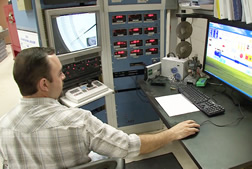
Adam Pacheco of shock and detonation physics presses the “fire” button during an experiment at the two-stage gas gun facility
LANL 11/3/2014— As U.S. nuclear weapons age, one essential factor in making sure that they will continue to perform as designed is understanding the fundamental properties of the high explosives that are part of a nuclear weapons system. A new video on the Los Alamos National Laboratory YouTube Channel (
https://www.youtube.com/watch?v=uiSJOuRM_WE&feature=youtu.be) shows how researchers use scientific guns to induce shock waves into explosive materials to study their performance and properties. Explosives research includes small, contained detonations, gas and powder gun firings, larger outdoor detonations, large-scale hydrodynamic tests, and at the Nevada Nuclear Security Site, underground sub-critical experiments. In small-scale experiments, scientists are also looking at very basic materials such as ammonia and methane which are of interest in planetary physics, and simple molecules like benzene to better understand chemical reactivity at pressures that exceed those at the center of the Earth. Ultimately, the data from both small- and large-scale experiments are used to validate and improve computer models and simulations of the highly integrated, complex systems that comprise a nuclear weapon, enhancing confidence in the U.S. Nuclear Deterrent without the need for full-scale nuclear testing.

View LANL Data Science Press Release
October 14, 2014 — Four Corners methane hotspot points to coal-related sources

Los Alamos National Laboratory measurement instruments were placed in the field for analysis of Four Corners area in U.S. southwest power plant emissions.
LANL 10/14/2014—A large, persistent “hot spot” of methane (natural gas) covering 2,500 square miles (half the area of Connecticut) has existed over the Four Corners intersection of Arizona, Colorado, New Mexico, and Utah since 2003. Remote sensing observations, taken continuously by Los Alamos National Laboratory (LANL) through 2011 and 2012, showed large morning increases of methane, but a European satellite had measured methane in that area daily 2003–2009 before. After seeing that earlier data, a team of LANL, NASA, and University of Michigan scientists followed up with high-resolution regional atmospheric modeling of the current methane emissions for the region reported by the Environmental Protection Agency (EPA). When they compared the simulated methane with both ground and satellite observations, they found the EPA results were two low by a factor of three. The team concludes that the earlier emissions were from coal-bed methane operations that preceded widespread hydraulic fracturing in that area for oil or gas. Methane is 25 times more potent a greenhouse gas than carbon dioxide at trapping heat in the atmosphere and contributes to global warming. The findings were reported in
Geophysical Research Letters.
View LANL Data Science Press Release
September 25, 2014 — Climate, Earth system project draws on science powerhouses
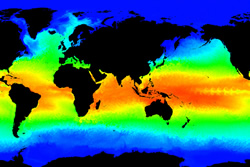
Computer modeling provides policymakers with essential information on such data as global sea surface temperatures related to specific currents.
LANL 9/25/2014—The US Department of Energy national laboratories are teaming with academia and the private sector to develop the most advanced climate and Earth system computer model yet created. Accelerated Climate Modeling for Energy (ACME) is designed to accelerate the development and application of fully coupled, state-of-the-science Earth system models for scientific and energy applications. The project—which includes seven other national laboratories, four academic institutions, and one private-sector company—will focus initially on three climate-change science drivers and corresponding questions to be answered during the project's initial phase: water cycle, biogeochemistry, and cryosphere systems. Over a planned decade, the project aims to conduct simulations and modeling on the most sophisticated high-performance computing systems machines as they become available: 100+ petaflop machines and eventually exascale supercomputers.
View LANL Data Science Press Release
September 23, 2014 — Los Alamos researchers uncover new properties in nanocomposite oxide ceramics for reactor fuel, fast-ion conductors
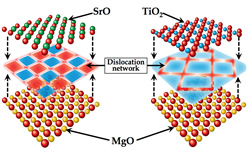
Schematic depicting distinct dislocation networks for SrO- and TiO2-terminated SrTiO3/MgO interface
LANL 9/23/2014—Nanocomposite oxide ceramics have potential uses as ferroelectrics, fast ion conductors, and nuclear fuels and for storing nuclear waste. A composite is a material containing grains, or chunks, of several different materials; in a nanocomposite, the size of each grain is on the order of nanometers, roughly 1000 times smaller than the width of a human hair. Interfaces where the different materials meet are regions of unique electronic and ionic properties, which could enhance conductivity of batteries and fuel cells. Los Alamos National Laboratory (LANL) simulations that explicitly account for the position of each atom within two different materials reveal that some interfaces exhibit remarkably different atomic structures: misfit dislocations that form when the two materials do not exactly match in size dictate the functional properties of the interface, such as the conductivity. The observed relationship between the termination chemistry and the dislocation structure of the interface offers potential avenues for tailoring transport properties and radiation damage resistance of oxide nanocomposites by controlling the termination chemistry at the interface. The research is described in a paper published in the journal
Nature Communications.
View LANL Data Science Press Release
September 15, 2014 — Collaboration drives achievement in protein structure research
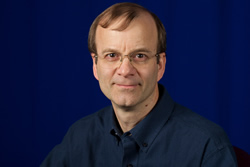
Thomas Terwilliger
LANL 9/15/2014—Computational analysis is key to structural understanding of a molecular machine that targets viral DNA. Researchers at Montana State University have provided the first blueprint of a bacterium’s “molecular machinery,” showing how bacterial immune systems fight off the viruses that infect them. By tracking down how bacterial defense systems work, the scientists can potentially fight infectious diseases and genetic disorders. The key is a repetitive piece of DNA in the bacterial genome called a CRISPR (Clustered Regularly Interspaced Short Palindromic Repeats). The bacterial genome uses the CRISPR to capture and “remember” the identity of an attacking virus. Now the scientists have created programmable molecular scissors, called nucleases, that are being exploited for precisely altering the DNA sequence of almost any cell type of interest. LANL—along with partners Lawrence Berkeley National Laboratory and Duke and Cambridge University—developed software to analyze the protein structure of the nuclease, which was key to understanding its function. The researchers reported their findings in the journal
Science.
View LANL Data Science Press Release
September 8, 2014 — Los Alamos conducts important hydrodynamic experiment in Nevada
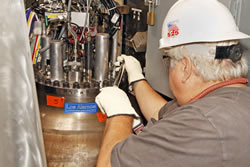
Technicians at the Nevada National Security Site make final adjustments to the "Leda" experimental vessel in the "Zero Room" at the underground U1a facility.
LANL 9/8/14—On August 12, 2014, Los Alamos National Laboratory (LANL) successfully fired the latest in a series of experiments at the Nevada National Security Site (NNSS). The experiment, called Leda, consisted of a plutonium surrogate material and high explosives to implode what weapon physicists call a “weapon-relevant geometry.” Hydrodynamic experiments such as Leda involve surrogate non-nuclear materials that mimic many of the properties of nuclear materials. Hydrodynamics refers to the fact that solids, under extreme conditions, begin to mix and flow like liquids. Scientists will now study the data in detail and compare with pre-shot predictions. The resulting findings will help physicists assess their ability to predict weapon-relevant physics and model weapon performance in the absence of full-scale underground nuclear testing.

View LANL Data Science Press Release
September 2, 2014 — Truly secure e-commerce: quantum crypto-keys

This small device developed at Los Alamos National Laboratory uses the truly random spin of light particles as defined by laws of quantum mechanics to generate a random number for use in a cryptographic key that can be used to securely transmit information between two parties.
LANL 9/2/2014—The largest information technology agreement ever signed by Los Alamos National Laboratory (LANL) brings the potential for truly secure data encryption to the marketplace after nearly 20 years of development. By harnessing the quantum properties of light for generating random numbers, and creating cryptographic keys with lightning speed, the technology enables a completely new commercial platform for real-time encryption at high data rates. If implemented on a wide scale, quantum key distribution technology could ensure truly secure commerce, banking, communications and data transfer. The Los Alamos technology is simple and compact enough that it could be made into a unit comparable to a computer thumb drive or compact data-card reader. Units could be manufactured at extremely low cost, putting them within easy retail range of ordinary electronics consumers.
View LANL Data Science Press Release
July 22, 2014 — Three Los Alamos scientists named ‘Most Influential Scientific Minds’
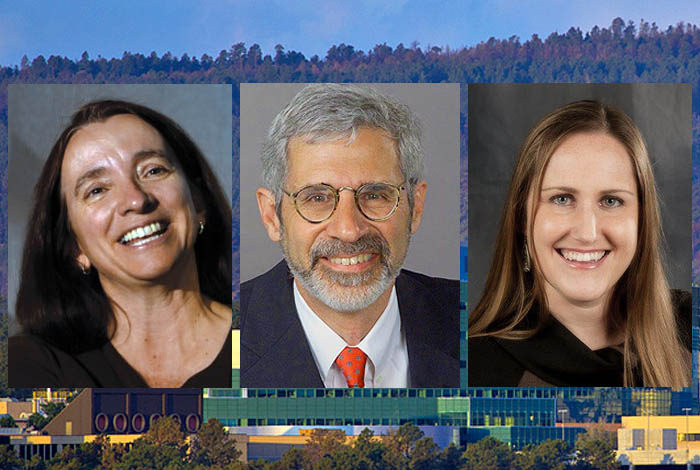
Left to right: Bette Korber, Alan Perelson and Allison Aiken
LANL 7/22/2014—Los Alamos National Laboratory (LANL) scientist Alan Perelson is one of three LANL researchers named to Thomson Reuters list of “The World’s Most Influential Scientific Minds.” Perelson—a Senior Fellow of the Laboratory’s Theoretical Biology and Biophysics group, an adjunct professor of bioinformatics at Boston University, an adjunct professor of biology at the University of New Mexico, and an adjunct professor of biostatistics at the University of Rochester’s School of Medicine—is part of a multinational team whose work contributed to the understanding of the Hepatitis C virus and a possible cure. In that work, a mathematical technique called “viral kinetic modeling” seeks to characterize the main mechanisms that govern the virus’s response to treatment. These computer simulations showed the drug in question blocked two distinct processes (like other antivirals), but also the release of the virus from infected cells. The research results indicate that daily viral production could be four times larger than previously thought, which has implications for the development of mutations that could lead to drug resistance.
View LANL Data Science Press Release
July 3, 2014 — Ribosome research in atomic detail offers potential insights into cancer, anemia, Alzheimer’s

The newly discovered rolling movement shown in (A) three-dimensional cryo-electron microscopy image of ribosome, and (B) computer-generated atomic-resolution model of the human ribosome consistent with microscopy. A). Arrows indicate the direction of movement during transition between the two different states. B). Ribbons represent backbone of RNA and protein molecules within the ribosome. Color bar indicates the amount of motion during rolling.
LANL, 7/3/2014—A groundbreaking study of the human ribosome is revealing that the tiny molecular machine is more versatile than previously understood. Ribosomes (found in all living cells) create proteins, making the ribosome one of life's most fundamental machines. This research shows that the ribosome is highly programmable, where minor changes in its sequencing can change its operation, allowing it to adapt to a changing environment, as described in a paper published July 3 in Cell. Specifically, the human ribosome shows subtle differences in overall structure that changes alter its inner workings, going from a molecular mechanism based on a ‘rocking’ motion to a ‘rolling’ motion. “Cracking the mechanism of human ribosomes will have applications to a variety of diseases, so we are now seeing the real payoff of over a decade of computer simulations of the ribosome,” said researcher Karissa Sanbonmatsu of Los Alamos National Laboratory (LANL).
View LANL Data Science Press Release
June 17, 2014 — High-performance computer system installed at Los Alamos National Laboratory
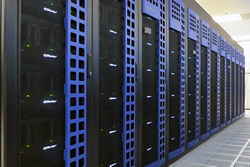
The Wolf computer system modernizes mid-tier resources for Los Alamos scientists.
LANL 6/17/14—Los Alamos National Laboratory (LANL) recently installed a new high-performance computer system, called Wolf, to be used for unclassified research. Wolf, manufactured by Cray Inc., has 616 compute nodes each with two 8-core 2.6 GHz Intel “Sandybridge” processors, 64 GB of memory, and a high speed Infiniband interconnect network. It utilizes the Laboratory’s existing Panasas parallel file system as well as a new one based on Lustre technology. The Wolf computing system operates at 197 teraflops per second. Collectively, the system has 9,856 compute cores and 19.7 terabytes of memory. It provides users with 86.3 million central processing unit core hours per year. Initial science research projects to utilize Wolf will include climate, materials, and astrophysics modeling.
View LANL Data Science Press Release
May 30, 2014 — Desert scientists turn to rainforest for climate answers
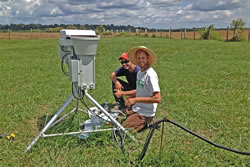
Los Alamos scientist Heath Powers, foreground, and on-site technician Vagner Castro work on field equipment for measuring carbon dioxide and water vapor near areas of human habitation in Brazil.
LANL 5/30/14—A team of scientists deployed to Brazil’s Amazon Basin is unraveling the mysteries of how land and atmospheric processes affect tropical hydrology and climate. Their work will go far toward improving the climate-prediction computer models on which scientists and policymakers rely for future climate-related planning. Their job is to go into climatically undersampled regions where there are not a lot of data and collect measurements aimed at fine-tuning climate modeling, both for more accurate design, and then for verification of conditions at specific locations. The experiment, Green Ocean Amazon (GOAmazon), has been underway since January 2014; nearly 100 collaborators from the US, Germany, and Brazil will be studying the rainforest through December 2015. The scientists and their technical assistants have been placing instruments at various sites in Brazil’s Amazon Basin, examining solar radiative energy, atmospheric moisture profiles, and measuring clouds’ and aerosols’ microphysical and chemical properties.
View LANL Data Science Press Release
May 26, 2014 — High-performance computing at Los Alamos announces milestone for key/value middleware

Billion inserts-per-second data milestone reached for supercomputing tool.
LANL 5/26/14— A data middleware project has achieved a milestone for specialized information organization and storage. The Multi-Dimensional Hashed Indexed Middleware (MDHIM) project at Los Alamos National Laboratory (LANL) recently achieved 1,782,105,749 key/value inserts per second into a globally-ordered key space on LANL’s Moonlight supercomputer. In the current highly parallel computing world, the need for scalability has forced the world away from fully transactional databases and back to the loosened semantics of key value stores. Computer simulations overall are scaling to higher parallel-processor counts, simulating finer physical scales or more complex physical interactions. As they do so, the simulations produce ever-larger data sets that must be analyzed to yield the insights scientists need. Traditionally, much data analysis has been visual; data are turned into images or movies. Statistical analysis generally occurs over the entire data set. But more detailed analysis on entire data sets is becoming untenable due to the resources required to move/search/analyze all the data at once. The ability to identify, retrieve, and analyze smaller subsets of data within the multidimensional whole would make detailed analysis much more practical. In order to do achieve this, however, it becomes essential to find strategies for managing these multiple dimensions of simulation data. The MDHIM project aims to create a middle-ground framework between fully relational databases and distributed but completely local constructs like “map/reduce.”
View LANL Data Science Press Release
May 8, 2014 — Laboratory researcher Joel Rowland to receive DOE Early Career Award

Joel Rowland
LANL 5/8/14 —Los Alamos National Laboratory researcher Joel Rowland is one of 35 national recipients of 2014 Early Career Research Program awards from the Department of Energy. Rowland’s research was recognized by DOE’s Office of Biological and Environmental Research for incorporating hydrological controls on carbon cycling in flood plain ecosystems into Earth System Models (ESM). Rowland has been a staff scientist since July 2010; his research focus has been on land surface dynamics in Arctic environments, with particular focus on how rivers and lakes in permafrost settings will respond to warming, permafrost loss and changes in hydrology. Rowland is part of the Laboratory’s Climate Ocean Sea Ice Modeling team on Arctic terrestrial hydrology and coupling terrestrial systems to ocean modeling. He also is part of DOE’s Next Generation Ecosystem Experiment Arctic research project team.
View LANL Data Science Press Release
April 16, 2014 — Los Alamos physicist honored with E.O. Lawrence Award
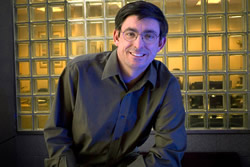
John Sarrao
LANL 4/16/14 — Los Alamos National Laboratory physicist John Sarrao is being honored by the U.S. Department of Energy with the 2013 Ernest O. Lawrence Award in Condensed Matter and Materials Sciences. The citation reads: “For the discovery and study of new materials, especially those based on plutonium, advancing understanding of unconventional magnetic and superconducting states in strongly correlated f-electron condensed matter systems.” Sarrao has been the associate director for Theory, Simulation, and Computation at Los Alamos since March of 2013.
View LANL Data Science Press Release













